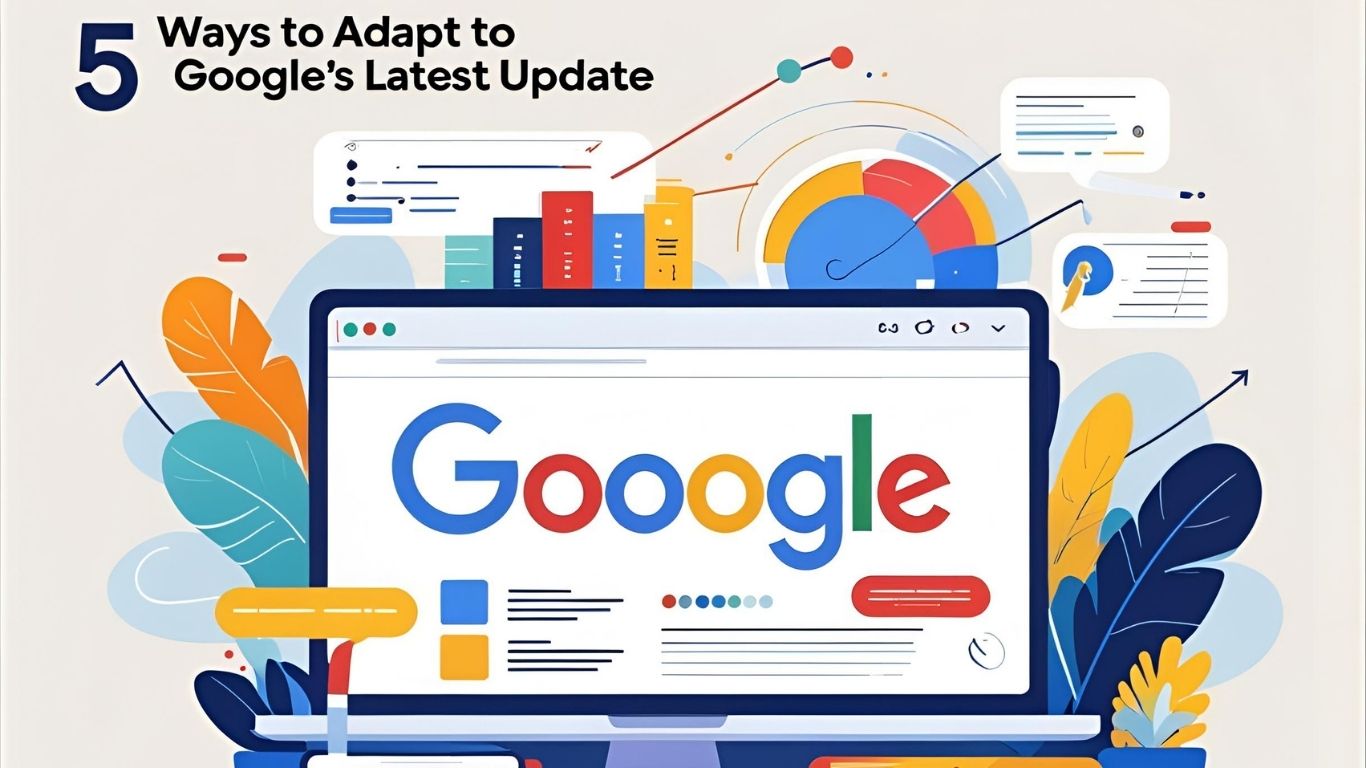How to Adapt to Google’s Algorithm Update: 5 Key Steps to Stay Ahead #SEO #GoogleUpdate #Rankings
How to Adapt to Google’s Algorithm Update: 5 Proven Steps
Adapting to Google’s ever-changing algorithm updates is a challenge that every website owner, content creator, and SEO specialist faces. Each update can have a significant impact on your website’s rankings and visibility. How to Adapt to Google’s Algorithm Update is no longer just a query—it’s a pressing concern that demands an effective response. This article will guide you through the steps you need to take to recover from any negative impacts and thrive in a landscape shaped by Google’s continuous updates. We’ll explore each step with detailed examples, providing you with strategies to stay ahead and keep your site ranking high.
How to Adapt to Google’s Algorithm Update: 5 Proven Steps
When you hear the news of a new Google algorithm update, it might feel like the world is about to crumble beneath your website’s feet. But don’t panic. Instead, embrace the opportunity to rethink your strategy and strengthen your site for long-term SEO success. How to Adapt to Google’s Algorithm Update isn’t just about recovery—it’s about proactive change. From content optimization to mobile readiness, we’ll walk you through five actionable steps that will help your website not only recover but thrive.
Understanding Google’s Algorithm Update
Before we jump into the recovery strategies, let’s first take a deeper look at how to adapt to Google’s algorithm update. Understanding the update itself is critical. Google doesn’t simply change things for the sake of it—these changes aim to improve user experience and deliver the best possible content for every query. The updates typically focus on factors like content quality, mobile optimization, site speed, and user engagement. Staying ahead of these changes means understanding their core features and implications.
Key Features of the Update
Google algorithms are designed to promote sites that meet specific criteria, ensuring users are directed to the most relevant, useful, and high-quality pages. Recent updates, like the Core Web Vitals update, have placed greater emphasis on speed, mobile usability, and overall user experience.
These updates highlight the importance of providing value to your audience. If your content is high-quality and your site is easy to navigate, you are more likely to see positive results. But, how to adapt to Google’s algorithm update if your site isn’t in top form yet? It’s all about making necessary adjustments, so let’s move on to the next step.
Step 1 – Assess Your Current SEO Health
Before diving into major changes, it’s crucial to take a step back and evaluate your website’s current state. A website audit is the first step in understanding how to adapt to Google’s algorithm update. You can’t fix what you haven’t identified as broken. Analyzing your site’s health involves checking for performance issues, identifying areas for improvement, and laying out a plan for recovery.
Conduct a Site Audit
A site audit involves examining your website from a technical perspective, identifying issues like broken links, duplicate content, and slow loading times. Tools like Google Search Console, SEMrush, or Ahrefs can help you pinpoint these issues. Once you’ve completed the audit, it’s time to work on fixing these issues. A clean and well-organized site will be better equipped to handle the next update.
Analyze Core Web Vitals
Google’s recent updates heavily prioritize user experience, especially factors like page loading speed and interactivity. Core Web Vitals are critical performance indicators of your website’s user experience. These metrics are:
Largest Contentful Paint (LCP): Measures loading performance.
First Input Delay (FID): Measures interactivity.
Cumulative Layout Shift (CLS): Measures visual stability.
If your Core Web Vitals scores aren’t meeting the thresholds Google sets, your rankings may be negatively affected. Implementing tools like Google’s PageSpeed Insights can provide the data you need to optimize your site’s performance.
Review Your Backlink Profile
Backlinks remain one of the most powerful ranking signals in Google’s algorithm. A strong, diverse backlink profile indicates authority and trustworthiness. On the flip side, harmful or toxic backlinks can harm your SEO. By regularly reviewing your backlink profile and removing any harmful links, you can ensure your site’s reputation stays intact. In this ever-evolving digital landscape, the ability to adapt is what keeps you ahead.
Step 2 – Optimize Content Quality
Once you’ve assessed your site’s health, the next step in how to adapt to Google’s algorithm update is optimizing your content. Google has always favored high-quality content, and recent updates have only reinforced that fact. To stay ahead, your content needs to be informative, engaging, and aligned with user intent.
Improve Content Relevance
Google aims to match the best possible content to each search query. If your content isn’t directly answering the questions users are asking, your rankings may drop. Focus on crafting content that directly addresses user needs. You can start by conducting keyword research to find long-tail keywords that align with your target audience’s search intent.
Enhance User Engagement
Content isn’t just about writing for search engines—it’s about writing for people. Engaging content encourages users to stay on your page longer, reducing bounce rates and increasing the chances of conversion. Consider adding elements like multimedia (videos, images, infographics) and interactive features (quizzes, polls) to boost user engagement.
Focus on EAT (Expertise, Authority, Trust)
Google has always prioritized authoritative content. The recent updates have put even more emphasis on EAT—Expertise, Authoritativeness, and Trustworthiness. Establish your authority by creating content based on deep knowledge, citing credible sources, and gaining backlinks from reputable websites in your niche.
Step 3 – Mobile Optimization
Mobile optimization is no longer optional. With the rise in mobile-first indexing, Google now prioritizes the mobile version of your site over the desktop version when determining rankings. How to adapt to Google’s algorithm update? Make sure your website is fully optimized for mobile. A poor mobile experience can result in lower rankings, so addressing mobile usability is crucial.
Importance of Mobile-Friendliness
Mobile-friendliness means ensuring that your website is responsive, fast, and easy to navigate on smaller screens. Test your site on different devices and make adjustments where necessary. Google’s Mobile-Friendly Test tool is an excellent resource for assessing your site’s mobile performance.
Google’s Mobile-First Indexing
With mobile-first indexing, Google now looks at your mobile site before considering your desktop version. This makes mobile optimization a top priority. Ensure that your mobile site has all the same content as the desktop version, including text, images, and videos.
Tools for Testing Mobile Usability
Google’s Mobile-Friendly Test and Lighthouse are two tools you can use to test how well your site performs on mobile devices. These tools give you valuable insights into any issues that need fixing. Implementing changes based on these insights will help your website stay ahead of algorithm updates.
Step 4 – Improve Technical SEO
Technical SEO refers to the aspects of your website that improve its crawlability and indexability by search engines. These elements play a significant role in how to adapt to Google’s algorithm update, ensuring your site performs optimally.
Fix Crawl Errors
Crawl errors occur when search engine bots are unable to access certain pages on your website. Use tools like Google Search Console to identify crawl errors and fix them promptly. Ensuring that your site is easily accessible will improve its rankings.
Optimize Site Speed
Site speed is a critical ranking factor. A slow-loading website leads to higher bounce rates and lower rankings. Compress images, leverage browser caching, and use a content delivery network (CDN) to speed up your site’s load times.
Ensure Proper Indexing
Make sure all of your important pages are being indexed by Google. Use the “noindex” tag for pages you don’t want to appear in search results and ensure that your XML sitemap is up to date.
Step 5 – Recovery and Maintenance Post-Update
After implementing these strategies, it’s important to monitor your site and keep optimizing. Recovery from a Google algorithm update isn’t instant, but consistent effort will yield results over time.
How to Recover Lost Rankings
If your site has lost rankings after an update, don’t panic. Start by implementing the changes discussed earlier, then monitor your rankings over time. Recovery may take a few weeks, but don’t stop optimizing.
Proactive Monitoring
Use tools like Google Analytics and Google Search Console to track your website’s performance. Regular monitoring helps you stay on top of any issues and make adjustments before they affect your rankings.
Ongoing Optimization Strategies
SEO isn’t a one-time fix; it’s an ongoing process. Regularly update your content, perform technical SEO audits, and engage with your audience to ensure your site remains optimized for future updates.
Conclusion
Adapting to Google’s algorithm updates is not a matter of reacting to changes—it’s about proactive adaptation. By assessing your site’s health, optimizing content, ensuring mobile-friendliness, improving technical SEO, and focusing on recovery and maintenance, you can stay ahead of the curve. The key is consistency. How to adapt to Google’s algorithm update is a process that never truly ends, but by embracing these steps, you can continue to improve your website’s performance with each update.
Affiliate Opportunity: Consider signing up for tools like SEMrush, Ahrefs, or Google Search Console to aid your SEO journey. These tools will help you conduct audits, monitor performance, and stay ahead of algorithm updates.
Ad Opportunity: Looking for professional SEO services? Let’s help you adapt to Google’s algorithm updates with custom-tailored strategies. Contact us today!
Bullet-Point Summary:
- Understanding Google’s Algorithm Update: Know the core features and key changes in Google’s updates to adapt effectively.
- Step 1 – Assess SEO Health: Conduct a site audit, analyze Core Web Vitals, and review backlink profiles to identify areas of improvement.
- Step 2 – Optimize Content Quality: Focus on content relevance, user engagement, and EAT (Expertise, Authority, Trust).
- Step 3 – Mobile Optimization: Ensure mobile-friendliness and test mobile usability to align with Google’s mobile-first indexing.
- Step 4 – Improve Technical SEO: Fix crawl errors, optimize site speed, and ensure proper indexing for better search engine accessibility.
- Step 5 – Recovery & Maintenance: Implement strategies for recovery post-update, continuously monitor site performance, and keep optimizing.
- Actionable Steps: Use tools like Google Search Console, SEMrush, and Google Analytics to track improvements.
- Proactive Monitoring: Regular site audits and performance monitoring ensure continuous alignment with Google’s updates.
- Content Quality Matters: Focus on creating high-quality, engaging content that aligns with user intent and Google’s priorities.
- Ongoing SEO: SEO is an ongoing effort. Regular updates, improvements, and engagement are crucial for sustained success.
- Recovery Time: It may take time to recover rankings, but with consistent effort, your site can bounce back stronger.
Frequently Asked Questions (FAQs)
What is Google’s latest algorithm update?
Google’s latest algorithm update focuses on improving user experience by prioritizing high-quality content, mobile optimization, and page speed. It also emphasizes Core Web Vitals, which measure loading performance, interactivity, and visual stability.
How can I assess my website’s SEO health?
To assess your website’s SEO health, conduct a site audit using tools like Google Search Console, SEMrush, or Ahrefs. These tools help you identify technical issues, content gaps, and potential SEO improvements.
What is Core Web Vitals?
Core Web Vitals are three metrics that Google uses to measure user experience on your site: LCP (Largest Contentful Paint), FID (First Input Delay), and CLS (Cumulative Layout Shift). Improving these factors can help boost your rankings.
How do I improve my content quality for SEO?
To improve your content quality, ensure it is relevant, informative, and engaging. Focus on answering user queries, using targeted keywords, and maintaining EAT (Expertise, Authority, Trust) in your content.
Why is mobile optimization important for SEO?
Mobile optimization ensures that your site performs well on mobile devices. Google prioritizes mobile-first indexing, meaning it uses the mobile version of your site for ranking purposes. A mobile-friendly site is essential for maintaining high rankings.
How do I fix crawl errors on my website?
Crawl errors can be identified using Google Search Console. Once found, you can fix these errors by ensuring the pages are accessible to search engine bots and resolving any technical issues like broken links or blocked resources.
How can I recover lost SEO rankings after an update?
To recover rankings, assess your site’s health, optimize content, improve mobile performance, and fix any technical issues. Regularly monitor your site’s performance and adapt to any future Google updates.
What is mobile-first indexing?
Mobile-first indexing means that Google uses the mobile version of your site to rank and index pages. Therefore, ensuring your mobile site is optimized for speed, usability, and content quality is essential for better rankings.
How do I improve my site’s page speed?
You can improve page speed by compressing images, leveraging browser caching, and using a content delivery network (CDN). Tools like Google PageSpeed Insights can help identify specific improvements.
What tools can help monitor my website’s performance?
Tools like Google Analytics, Google Search Console, SEMrush, and Ahrefs are excellent for monitoring your website’s SEO performance. These tools provide valuable insights and help identify areas for improvement.
What are the best practices for technical SEO?
Best practices for technical SEO include fixing crawl errors, improving site speed, ensuring proper indexing, and implementing structured data (schema markup). These changes improve your website’s crawlability and overall SEO performance.
How do I know if my site is mobile-friendly?
You can test your site’s mobile-friendliness using Google’s Mobile-Friendly Test tool. This tool will highlight any issues affecting your mobile site and suggest areas for improvement.
Why is user engagement important for SEO?
User engagement signals to Google that your content is valuable and relevant. Metrics like time on page, bounce rate, and social shares are all indicators that can positively impact your rankings.
What is EAT in SEO?
EAT stands for Expertise, Authority, and Trust. Google favors content that demonstrates a high level of expertise, comes from authoritative sources, and is trustworthy. Focusing on these aspects can help improve your rankings.
How often should I update my website for SEO?
SEO is an ongoing process. Regular updates, including adding fresh content, optimizing for new keywords, and improving user experience, will help your website stay relevant and maintain or improve its rankings.
Explore These Valuable Resources
To further enhance your understanding of SEO and Google’s algorithm updates, we’ve curated a list of authoritative resources. These links will provide you with deeper insights, expert opinions, and the latest industry best practices.
Google Search Central Blog
Stay updated on Google’s algorithm updates, best practices, and SEO strategies directly from Google. This is the official blog where Google shares insights and tips to help you optimize your site.
Moz Blog
Moz is a leader in the SEO field, and their blog provides valuable articles on improving search rankings, understanding algorithms, and mastering SEO tactics.
Search Engine Journal
A go-to resource for up-to-date SEO news, trends, and in-depth guides on algorithm changes, content strategies, and optimization tips from industry leaders.
Ahrefs Blog
Ahrefs offers some of the best content for understanding technical SEO, link building, keyword research, and algorithm changes, backed by data-driven insights.
Backlinko by Brian Dean
Brian Dean’s blog is a treasure trove of actionable SEO techniques and strategies. His in-depth guides often dissect algorithm updates and provide practical advice on improving rankings.
Neil Patel’s Blog
Neil Patel’s website provides extensive tutorials on SEO, content marketing, and digital strategies, all based on the latest search engine trends.
Google’s Webmaster Guidelines
Google’s official webmaster guidelines give you a comprehensive overview of the principles and best practices for optimizing your website according to Google’s standards.
SEM Rush Blog
SEM Rush provides great resources on SEO tools, trends, and techniques for mastering content marketing, SEO, and understanding updates like Core Web Vitals.
Search Engine Land
Search Engine Land is a trusted resource for breaking news, analysis, and insights related to Google updates, algorithm changes, and SEO industry trends.
Yoast SEO Blog
Yoast is known for its SEO plugin, and their blog offers expert advice on both technical SEO and content optimization to align with Google’s latest updates.
HubSpot Blog
HubSpot’s blog offers a wealth of knowledge on inbound marketing, SEO, content creation, and strategy, helping businesses adapt to ongoing changes in search engine algorithms.
Content Marketing Institute
If you want to dive deeper into content strategies and learn how to adapt your content marketing to SEO trends, CMI provides exceptional resources.
Google Analytics Academy
For tracking SEO performance and understanding key metrics, Google’s own training platform helps you master Google Analytics and use data to improve your website’s SEO.
Bing Webmaster Guidelines
While Google is the dominant search engine, optimizing for Bing can still bring traffic. This guide provides essential tips for optimizing your site for Bing’s search algorithm.
Content Distribution by Buffer
Buffer’s resources on content distribution give valuable strategies for expanding your content’s reach, improving engagement, and supporting your SEO efforts.
These links are essential for mastering the SEO landscape. Whether you are a beginner or an advanced SEO practitioner, these resources will expand your knowledge and keep you ahead of the curve. By incorporating these strategies, you can continue optimizing your site in line with Google’s algorithm updates.
Blog Recommendation
For more insights on improving your website’s performance and staying updated with the latest trends in digital marketing, check out this blog. It’s a great resource for staying informed and ahead of the competition.
Explore Our Services
Looking for tailored SEO strategies and solutions to adapt to Google’s algorithm updates? Explore our range of services designed to help businesses boost their online presence and stay competitive in the ever-changing digital landscape.
Check Our Portfolio
Want to see real-world examples of our work? Visit our portfolio to explore projects where we’ve helped businesses optimize their websites and improve their SEO performance.
Shop for SEO Tools
Get the best tools and resources to boost your SEO game. Visit our shop for SEO tools and services that will help you adapt and thrive in a post-update Google landscape.
Connect with Us on LinkedIn
Stay connected and engage with us on LinkedIn. Check out our LinkedIn profile for updates, SEO tips, and professional networking opportunities.






